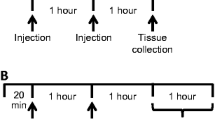Summary
Recent studies have demonstrated that selective monoamine oxidase inhibition may induce changes in brain β-phenylethylamine availability following lesions. The present study used this approach to re-assess the possible effects of reserpine on striatal concentrations of β-phenylethylamine and of other amines and selected metabolites. Mice were injected with pargyline (2,200 mg kg−1, 4 h), clorgyline (2 mg kg−1, 2 h) or (−)deprenyl (2 mg kg−1, 2 h) alone or in combination with reserpine (1,10 mg kg−1, 2 h). Increases in β-phenylethylamine accumulation were observed in the presence of both (−)deprenyl or pargyline respectively after reserpine except in the case of combined 200 mg kg−1 of pargyline plus 1 mg kg−1 of reserpine. In this condition, a minimal dopamine decrease was observed (to 80% of the concentration of pargyline-treated controls). Increases in β-phenylethylamine concentration were not observed with reserpine alone (1 or 10 mg kg−1). In the latter condition, the concentrations of β-phenylethylamine remained at control values due to the activity of monoamine oxidase B. Changes in p-tyrosine, 5-hydroxytryptamine or tryptophan did not consistently accompany increases in β-phenylethylamine accumulation. Increased β-phenylethylamine accumulation was always accompanied by the decreases in dopamine induced by reserpine in mice with either non-selective (200 mg kkg−1 pargyline) or type B monoamine oxidase inhibition (2 mg kg−1 pargyline or deprenyl). These data suggest that although the changes in β-phenylethylamine accumulation may not be due simply to p-tyrosine availability they are related to dopamine levels in the intact striatum.
Similar content being viewed by others
References
Bertler A (1961) Effect of reserpine on the storage of catecholamines in brain and other tissues. Acta Physiol Scand 51:75–83
Boulton AA, Juorio AV, Philips SR, Wu PH (1977) The effects of reserpine and 6-hydroxydopamine on the concentration of some aryl alkylamines in rat brain. Br J Pharmacol 59:209–214
Colpaert FC (1987) Pharmacological characteristics of tremor, rigidity and hypokinesia induced by reserpine in the rat. Neuropharmacology 26:1431–1440
Durden DA, Philips SR, Boulton AA (1973) Identification and distribution of β-phenylethylamine in the rat. Can J Biochem 51:995–1002
Greenshaw AJ, Juorio AV, Nguyen TV (1986) Depletion of striatal β-phenylethylamine following dopamine but not 5-HT denervation. Brain Res Bull 17:477–486
Holzbauer M, Vogt M (1956) Depression by reserpine of the noradrenaline concentration in the hypothalamus of the cat. J Neurochem 1:8–11
Juorio AV, Kazakoff CW (1984) The presence of β-phenylethylamine, p-tyramine, m-tyramine and tryptamine in ganglia and foot muscle of the garden snail (Helix aspersa). Experientia 40:549–551
Koe BK, Weissman A (1966) p-Chlorophenylalanine: a specific depletor of brain serotonin. J Pharmacol Exp Ther 154:499–516
Kwok RPS, Juorio AV (1986) The concentration of striatal tyramine and dopamine metabolism in diabetic rats and the effect of insulin administration. Neuroendocrinology 43:590–596
Lauber J, Waldmeier PC (1984) Determination of 2-phenylethylamine in rat brain after monoamine oxidase inhibitors, and in human CSF and urine by capillary GC and chemical ionization MS. J Neural Transm 60:247–264
Neff NH, Yang H-YT (1974) Another look at monoamine oxidase and the monoamine oxidase inhibitor drugs. Life Sci 14:2061–2074
Philips SR, Boulton AA (1979) The effects of monoamine oxidase inhibitors on some aryl alkylamines in rat striatum. J Neurochem 33:159–167
Schlosberg AV, Harvey JA (1979) Effects of L-DOPA and 5-hydroxytryptophan on locomotor activity of the rat after selective or combined destruction of central catecholamine and serotonin neurons. J Pharmacol Exp Ther 211:296–304
Shore PA, Silver SL, Brodie BB (1955) Interaction of reserpine, serotonin and lysergic acid diethylamide in brain. Science 122:284–285
Spector S, Sjcerdsma A, Udenfriend S (1965) Blockade of endogenous norepinephrine synthesis by a methyl-p-tyrosine. J Pharmacol Exp Ther 147:86–95
Waldmeier PC, Buchle AM, Lauber J (1985) Cerebral 2-phenylethylamine concentrations and turnover not influenced by various pharmacological treatments in rats. In: Boulton AA, Maitre L, Bieck PR, Riederer P (eds) Neuropsychopharmacology of the trace amines. Humana Press Inc., New Jersey, pp 15–26
Author information
Authors and Affiliations
Additional information
Send offprint requests to A. V. Juorio at the above address
Rights and permissions
About this article
Cite this article
Juorio, A.V., Greenshaw, A.J. & Wishart, T.B. Reciprocal changes in striatal dopamine and β-phenylethylamine induced by reserpine in the presence of monoamine oxidase inhibitors. Naunyn-Schmiedeberg's Arch Pharmacol 338, 644–648 (1988). https://doi.org/10.1007/BF00165628
Received:
Accepted:
Issue Date:
DOI: https://doi.org/10.1007/BF00165628




